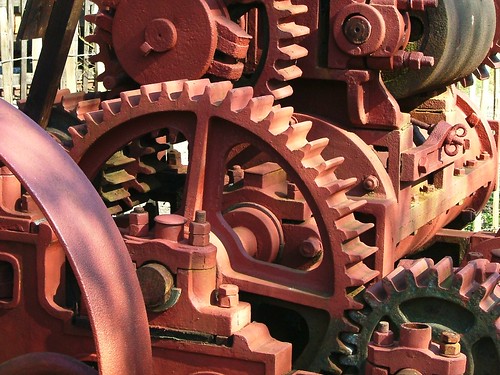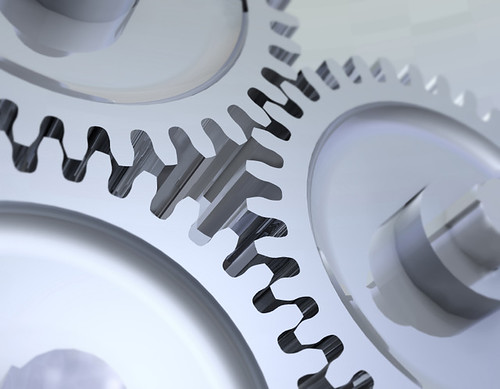| |
|
 |
| Gears gears cogs bits n pieces |
by Elsie esq. on Flickr |
|
A Simple Machine is a mechanical device that changes the direction or magnitude of a force. In general, they can be defined as the simplest mechanisms that use mechanical advantage (also called leverage) to multiply force. - A simple machine uses a single applied force to do work against a single load force.
- Ignoring friction losses, the work done on the load is equal to the work done by the applied force.
- They can be used to increase the amount of the output force, at the cost of a proportional decrease in the distance moved by the load.
- The ratio of the output to the input force is called the mechanical advantage.
Usually the term refers to the six classical simple machines which were defined by Renaissance scientists:
- Lever
- Wheel and axle
- Pulley
- Inclined plane
- Wedge
- Screw
|
 |
| motion gears -team force |
by ralphbijker on Flickr |
|
A Gear is a rotating machine part having cut teeth, or cogs, which mesh with another toothed part in order to transmit torque.
- Two or more gears working in tandem are called transmission and can produce a mechanical advantage through a gear ratio and thus may be considered a simple machine.
- Geared devices can change the speed, magnitude and direction of a power source.
- The most common situation is for a gear to mesh with another gear, however a gear can also mesh a non-rotating toothed part, called a rack, thereby producing translation instead of rotation.
- The gears in a transmission are analogous to the wheels in a pulley.
- An advantage of gears is that the teeth of a gear prevent slipping.
- When two gears of unequal number of teeth are combined a mechanical advantage is produced, with both the rotational speeds and the torques of the two gears differing in a simple relationship
|
 |
| old wagon |
by Rennett Stowe on Flickr |
|
Wheel and Axle is a simple machine. - It is a modified lever of the first class that rotates in a circle around a center point or fulcrum.
- The larger wheel (or outside) rotates around the smaller wheel (axle).
- Bicycle wheels, ferris wheels, and gears are all examples of a wheel and axle.
- Wheels can also have a solid shaft with the center core as the axle such as a screwdriver or drill bit or the log in a log rolling contest.
- The traditional form as recognized in 19th century textbooks is as shown in the image.
- This also shows the most widely recognized application, i.e., lifting water from a well.
- The form consists of a wheel that turns an axle and in turn a rope converts the rotational motion to linear motion for the purpose of lifting.
|
|
A Pulley, also called a sheave or a drum, is a mechanism composed of a wheel on an axle or shaft that may have a groove between two flanges around its circumference. - A rope, cable, belt, or chain usually runs over the wheel and inside the groove, if present.
- Pulleys are used to change the direction of an applied force, transmit rotational motion, or realize a mechanical advantage in either a linear or rotational system of motion.
- It is one of the six simple machines.
- Two or more pulleys together are called a block and tackle.
|
 NeoK12.com - Educational Videos, Lessons, Quizzes & Presentations
NeoK12.com - Educational Videos, Lessons, Quizzes & Presentations


